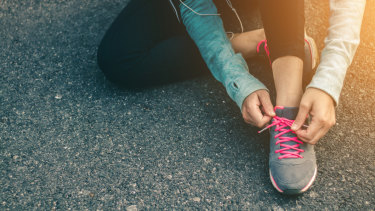He was the first man in history to break two hours in the marathon, but for this incredible feat, Kipchoge’s shoes have received almost as much attention as the runner himself.
The super maximalist Nike Vaporfly Next% running shoe will set you back about $320 and, with its carbon fibre plates and fluid-filled chambers, it claims to help improve your running economy by 4 per cent.
The best running shoe for you is not the best running shoe for everyone.Credit:Getty
There have been subsequent calls for the shoe to be banned but, regardless of the outcome, they are proof of just how performance-enhancing the humble trainer can be.
But are expensive running shoes inherently better? What actually makes a good running shoe?
New research by RunRepeat, the world’s largest athletic footwear review company, analysed 323,776 reviews and prices of 336 workout shoes from 20 different brands. Perhaps surprisingly, they found that the cheaper the shoe, the higher the ratings and user satisfaction.
“The top 10 most expensive workout shoes cost 183.05 per cent more and have a 2.3 per cent lower rating on average than the 10 cheapest workout shoes,” the report said. “The data makes it clear that expensive workout shoes are not better than more affordable ones.”
Dr John Arnold from the school of Health Sciences at the University of South Australia, says a sense of value for money can influence a buyer’s satisfaction levels about a shoe.
Running shoes can can have “a range of effects” including performance and changing the way we run, Arnold says, adding: “There’s also some evidence that shoes can alter the risk of injury.”
The kind of specific technology that has been shown to improve performance, like in Kipchoge’s shoes, will “probably be more confined to the higher end of the market”, he says.
And though you may or may not be getting a performance-enhancing shoe because of its price, more expensive shoes do typically have more features designed to increase comfort, which indirectly may improve performance.
“Though comfort isn’t always linked to how expensive a running shoe is,” says Arnold, whose research focus is biomechanics, running and footwear. “There’s a difference between the very cheapest shoes on the market [and the most expensive], the grey area is whether you want to $100 or $200 on a pair of running shoes.”
Comfort is, for many people, subjective and depend on whether they like more or less cushioning and more or less in-built stability. So it turns out the best shoe for you is not the best shoe for everyone, nor necessarily the most expensive.
As for whether the minimalist shoe or the maximalist, a la Kipchoge’s, is better, may be a matter of fashion.
“There’s been a constant cycle for the last 30-35 years. It’s driven by footwear companies … and I’d imagine that in 25 years time we’ll be doing a full circle again,” he says. “One of the most important things is whether the shoe feels right for you and comfortable when you’re getting them fitted."
John Arnold’s advice for finding the best shoe for you
- Get a pair of shoes that are designed for the activity you’re doing.
- Go into a store and get advice about the shoe that is best for you.
- Balance your requirements and what feels good against the results of a gait analysis or specialised fitting service.
- Once you buy a new pair of shoes, increasing your training regime gradually as going too rapidly can increase the risk of injury.
- The technology sometimes outpaces the evidence, so always choose comfort first.
The best and worst brands according to RunRepeat's research
- The three most poorly rated workout shoe brands: Merrell, Vivobarefoot, The North Face.
- The three best-rated workout shoe brands: NoBull, Skechers, Jordan.
- The three cheapest workout shoe brands: Avia, Skechers, Ryka.
- The three most expensive workout shoe brands: Vivobarefoot, NoBull, Inov-8.
Source: Read Full Article

